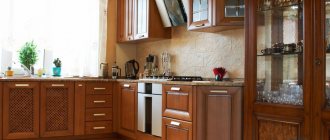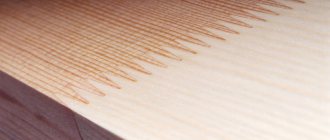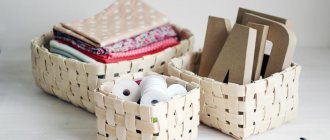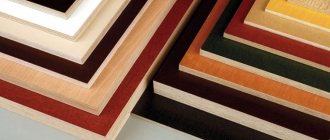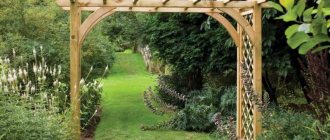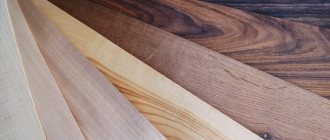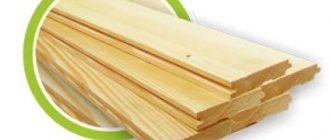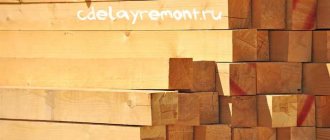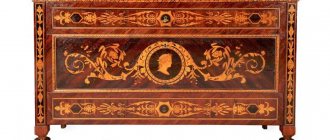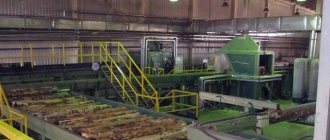Veneer is used as a finishing material. It consists of thin sheets of wood obtained by sawing. Sheet thickness is from 0.5 to 3 mm. Due to the large amount of forest land, starting a veneer business can be quite profitable.
Preparation of raw materials
Natural wood material is used as raw material. Both inexpensive pine and varieties of more valuable hardwood are used here. The technological process of preparing raw materials depends on the choice of manufacturing method. There are 3 ways to make veneer:
- Peeling;
- Planing;
- Sawing.
When using the peeling method, so-called churaki are made, which are part of the tree trunk. The length of the logs ranges from 0.8 to 3.2 m. For the production of sliced veneer, blanks of at least 1.5 m are used. The maximum diameter of the blank depends on the capabilities of the processing mechanisms. The minimum diameter size is 18 cm.
- The planed material is made from blanks with a diameter of at least 22 cm, after which square beams are made from them.
- Requirements for blanks:
- Minimum number of knots;
- No wormholes;
- No cracks or rot.
Rotary cut veneer
The technology for producing rotary-cut veneer consists of cutting the outer thin layer of wood from a rotating piece. The cutting process occurs in a spiral manner as the diameter of the trunk decreases. Sheets of such veneer are large in both width and length.
But cutting along the annual rings affects the appearance of the material. The wood structure here looks distorted, it has almost no resemblance to the appearance of sawn boards. Finished sheets are most often intended for the production of multi-layer plywood.
Production by sawing
The sawing method is the oldest existing method of producing veneer.
It is similar to the process of making boards. Only the thickness of the finished material here ranges from 1.2 to 10 mm. Unlike peeled specimens, sawn material completely preserves the natural structure of the wood pattern. Therefore, it is used for decorative purposes. The disadvantage of this method is the large amount of waste, since a significant part of the raw materials turns into sawdust.
Production of sliced veneer
The planing method, like sawing, preserves the natural pattern of the wood structure, only here knives, rather than saws, are used.
If we compare planing with peeling technology, where knives are also used, then here veneer is produced not by circularly cutting the surface of a rotating workpiece, but by removing layers from the planes of the timber. Depending on the types of machines used, the knife moves along or across the direction of the wood fibers.
Fine-line veneer
A modern natural material with properties similar to plastic. Distinctive features of fine line are its stability under conditions of temperature changes and resistance to high levels of humidity. Initially, the peeling method is used here. Inexpensive wood species are usually used as raw materials.
Thin blanks are glued together under a press, the surfaces are painted to look like valuable wood or any other material.
Despite the presence of glue and coloring components, fine line is considered an environmentally friendly natural coating, since its basis is natural wood. Its improved plasticity facilitates the process of processing and decorating surfaces.
One of the features of this material is both its advantage and disadvantage. The surface turns out to be too ideal, without the presence of natural flaws that are inherent in other types of veneer.
Veneer coating gives the products a refined appearance. Thicker layers can also improve the physical properties of decorated surfaces.
You can make veneer with your own hands, but without skills in working with wood and without access to a certain set of woodworking machines, this will not be possible.
Do you have woodworking skills in your arsenal of abilities?
Edge veneering
To glue veneer onto an edge, all you need is PVA glue, a brush, a block and an iron. The work is carried out in stages. AmarantPro YouTube channel .
A strip 10 mm wider than the edge of the plywood base is cut out of the veneer. The veneer strip is coated with glue. Coat the strip carefully so that the glue does not protrude from the back side, as they will run a hot iron over it.
Coating veneer with glue
A thick layer of glue is applied to the edge of the workpiece, which is fixed motionless. There are no missed or poorly coated areas left on it. Apply the thickest layer to the corners to ensure a tight adhesion.
Applying glue to the edges
Materials coated with glue are left to dry for a day.
At the final stage of the work, the veneer strip is connected to the base and smoothed onto the plane with a heated iron.
Smoothing veneer with an iron
The heating of the veneer is controlled by smell. As the veneer heats up, the strip is smoothed with a wooden block.
Smoothing veneer with a block and iron
The quality of veneer gluing is assessed by tapping on the surface. Places where there are air pockets are re-smoothed with an iron.
After gluing the veneer onto the surface, glue the joints along the perimeter of the edge. To do this, the joints are processed at an angle with a hot iron.
Ironing edge joints
Excess veneer is cut off with a knife, and then the corners are processed with a block of sandpaper.
Sanding edge joints
This method is not used for gluing veneer on wide surfaces. In any case, the shirt is made from strips connected by a gummed film, and when heated with an iron, the joints separate.
Veneering (veneering) of edges in the video:
Peeled veneer - distinctive characteristics and production features
Veneer peeling is a technological wood processing process that involves cutting off the top layer of wood fibers from a wooden piece rotating around its axis.
Peeled veneer - what is it?
Peeled veneer
- Veneer is a building material consisting of flat, thin sheets of wood of varying thicknesses.
- Depending on the equipment used and production technology, veneer is produced with a thickness of 0.1 - 10.0 mm, and in accordance with the production method, it is classified as: sawn, planed and peeled.
- Peeled veneer is produced on special equipment, peeling machines, the principle of which is based on cutting layers of wood of a given thickness from a cylindrical blank rotating around its axis.
Various tree species are used to produce peeled veneer: birch, aspen, alder, beech, maple, linden, poplar, spruce, pine, larch, fir and cedar. It is used for the production of plywood and other board building materials (carpentry, plywood boards, etc.), for the manufacture and cladding of furniture.
Depending on the quality of the wood used, its species, as well as the quality of processing, depending on the type of equipment used, peeled veneer is divided into five grades, these are:
- E (elite), I, II, III, IV – for hardwood;
- Ex (elite), Iх, IIх, IIIx, IVx – for coniferous trees.
The document regulating the production of peeled veneer is GOST 99-96 “Rolled veneer. Technical conditions".
Currently, a new document has been developed, in accordance with which this building material will be produced in the near future, this is the Interstate standard “GOST 99-2016 Peeled veneer. Technical conditions”, which is currently being approved by regulatory organizations.
Distinctive characteristics
Thin rotary cut veneer
Experts believe that peeled veneer is not the best option when using it for finishing rooms or structural elements of furniture, as well as other structures. This is due to the low decorative properties of this material.
To improve its decorative qualities, veneer made by peeling is dyed, pyrotyped (hot printing) is performed, as well as other types of finishing.
Distinctive features of peeled veneer are:
- The veneer texture shows large gaps between the early and late layers of wood.
- Peeled is the thinnest type of veneer.
- When peeling curly wood, this type of veneer demonstrates high decorative qualities.
Curly wood is wood with a natural defect, expressed in a tortuous or random arrangement of wood fibers.
Comparative characteristics
Sliced veneer
Different types of veneers are used for different purposes, depending on the material's thickness, uses, and cost.
If we compare by thickness, this indicator looks like this:
- peeled veneer is produced in thicknesses from 0.1 to 10.0 mm;
- sliced veneer, thickness - from 0.2 to 5.0 mm;
- sawn veneer, thickness - from 1.0 to 10.0 mm.
Sawn veneer is made from coniferous trees, and the blanks are large-sized bars that are sawn in a given direction. This is the most expensive type of veneer, which is used for various types of finishing and even in the manufacture of musical instruments.
Sliced veneer is made from valuable tree species and is used for finishing furniture and interior decoration. This is a fairly expensive type of veneer, the price of which is determined by the cost of the wood used.
Peeled veneer is made from the most “simple” tree species (birch, oak, pine, alder), which determines its use in the production of plywood and other sheet finishing materials. As already written above, this is the cheapest type of veneer.
Production Features
Peeling machine
The technology for manufacturing peeled veneer has been known since the beginning of the 19th century, and over the years, the equipment used for the production of veneer has undergone many design changes and technical changes. However, the basic principles remain unchanged.
Churak, or in other words, the workpiece, which has previously been dried, is fed to a special peeling machine. The size of the block, length and diameter, depend on the model of the machine and its technical characteristics.
When the workpiece is fed to the machine, it is fixed in spindles, devices installed at the ends of the block.
An important point when installing a workpiece is correct alignment, because otherwise, during the next operation, rounding, there will be a large percentage of wood waste.
Properties of Karelian birch wood
The main thing that distinguishes Karelian birch from other types of wood is the properties of the wood.
They determine its popularity in the furniture market. For example, if we compare it with drooping wood (a type of wood), then there are clear advantages of its wood in terms of physical and mechanical properties:
- Wood from Karelia is denser - 0.712-0.740 kg/m3 versus 0.579-0.666 kg/m3.
- It resists compression more strongly and is harder at the ends.
- Solid Karelian birch is very hard, difficult to split, but can be easily processed with tools, which makes it possible to make durable, wear-resistant furniture from it. Her rival is much inferior in these indicators.
Where does Karelian birch grow?
Karelian birch is not a separate species - it is an anomalous subspecies of common birch, and the name that has gained a foothold in the market comes from the name of the area where it was first found, but it also grows in other regions.
Externally, the tree is undersized with a strongly curved trunk and the presence of spherical tubercles on it. Due to the peculiarities of the shape and the relatively short lifespan (usually 40-50 years, during which the tree does not have time to grow tall), only 10-25% of the logs have a valuable marble iridescent pattern. This factor and the fact that Karelian birch is a rare “guest on the planet” determine the established high price for furniture made from its solid wood.
In Russia, at the moment, this unique tree grows under natural conditions only in the forests of Karelia, but scientists have found a method to grow it artificially. Such industrial plantings are also available in Karelia, Kostroma, Moscow, Leningrad, Voronezh, and other regions.
In addition to Russia, there are several other countries where Karelian birch grows - the Baltic states, Belarus, the Czech Republic, as well as Scandinavian countries (Sweden, Denmark, Norway and others). They also engage in artificial propagation of the tree to obtain “royal wood.”
Varieties of “royal birch”
Karelian birch is found in nature in three main varieties, differing in the shape of the trunk, its height, structure and properties:
- Tall-stemmed (can be small or large tuberculate).
- Short-barreled.
- Bush-like.
The first two types are most suitable for furniture production, since they have a straighter trunk and a larger percentage of patterned wood. But they are inferior to the bush variety of Karelian birch in texture, which boasts a more interesting, more clearly expressed and rich pattern that does not require additional decorative finishing.
Wood texture and pattern features
The formation of texture in Karelian birch occurs gradually - the older the tree, the more beautiful the pattern:
- In bushy trees - by 30-40 years.
- For short-barreled ones - by 50-60 years.
- In tall trees - by 70-80 years.
Furniture made from Karelian birch, photo examples of which can be seen in our article, with its beauty outshines products from such well-known varieties as “bird’s eye” maple, walnut and Amur ash, pistachio wood, boxwood and plane tree, cherry, yew and others more common decorative breeds. It creates worthy competition for elite products made from teak and mahogany, checkerboard and all varieties of dalbergia.
By 3-5 years old, trees grown artificially begin to show external signs of patterning, and already at 15-20 years old, patterned specimens can be identified quite accurately.
Features of the wood texture of Karelian birch:
- Disordered tortuous arrangement of wood fibers.
- The presence of darker inclusions that visually resemble the letter V, elongated commas, sinuous lines or wavy dashes.
- Uneven pattern. It may be more uniform or have a clump character.
Array color range
Fans of light wood species will definitely like Karelian birch - the color of the furniture is mainly white, but can be light yellow or brownish (meaning the background). Inclusions are always noticeably darker than the background - often dark brown, less often almost black or with a reddish tint. Their size varies from 2 to 20 mm, but more often 4-6 mm. The pattern may also contain light paths (“frosty patterns”) with a length of 5 to 20 mm. Another uniqueness of Karelian birch is the moire pattern of its wood (light-colored fibers seem to shine through darker ones, creating a glowing effect), which visually makes furniture made from it even more unusual and richer.
Veneer machine
Expensive varieties of timber are excellent raw materials for creating furniture, but not all people can afford such expensive products.
In order to save valuable types of wood and reduce the cost of the final product, veneer was invented. This material is extremely popular today for cladding furniture.
Veneer 100% repeats the pattern, texture and shade of natural wood.
To create veneer, factories use special machines. Veneer can be:
- peeled
- planed
- sawn
Accordingly, there are three types of veneer production machine.
Peeling machine for veneer production
To implement peeling of veneer, the raw material must be pre-treated with steam in order to increase ductility. After this, the logs are fed to a debarking machine, where the bark is removed from the workpiece, along with dirt and sand, which often cause the peeling knives to quickly become dull.
Using a saw, the logs are cut into logs of a certain length. The churak must first be rounded, after which you can begin peeling. The veneer strip that comes out of the peeler is placed on a conveyor that feeds it to the shears. Scissors cut the veneer into sheets of the required format.
Along the conveyor, the veneer is placed into a bundle, which is taken out from under the shears and delivered to the dryer using an electric loader. The product is dried in a roller dryer, then it is sorted on a conveyor and put into bundles by grade. Defective sheets can be glued together.
If there are knots on the sheets, they are sent to a veneer repair machine, where the defects are removed and decorated with veneer inserts.
To increase the productivity and convenience of the operator, the machines are equipped with hydraulic lifts-center finders, which themselves determine the appropriate axis of rotation of the workpiece and combine it with the axis of rotation of the centering shafts.
Peeling of steamed wood is used for pine, alder, and birch timber. Plywood is made from peeled veneer.
Veneer planing machine
First of all, the ridges are subjected to transverse cutting. During this procedure, the ridges are cut into pieces of the required length. All sections are sawn lengthwise, resulting in a double-edged beam. Sometimes it is sawn in half. After this, the vanches are subjected to heat treatment in a steaming chamber or autoclave.
Next, the vanches need to be planed on a veneer cutting machine. Sliced veneer is dried in roller dryers, trimmed and packed into bundles. Each set contains a specific drawing. The wood shade and pattern must match in each set.
It is for this reason that the sheets of veneer that come out of each vanches during planing are folded, dried and packed into bundles exactly in the order in which they came out of the planer. When three vanches are planed at the same time, the veneer from each of them is folded into three different bundles.
A bundle of veneer that is completed, dried, packed and tied with twine is called a knol.
- radial
- tangential
- radial-tangential
- tangential-end.
The most attractive raw material for creating veneer is oak wood. This veneer is used for cladding rustic furniture in the luxury segment.
In addition to oak veneer, in specialized stores you can find maple, beech, linden, and mahogany materials.
Veneer stitching machine
Veneer is cut using specialized machines. It has a rather thin and fragile structure. In order to finish the surface with veneer, it must be joined together to obtain a sheet that is rolled into rolls. Veneer is joined in two ways:
These methods are equally popular in furniture production. Veneer stitching is carried out on a machine or manually. For small workshops, manual devices for gluing or stitching veneer have been developed. Using a special device, the adhesive or thermal thread is heated and applied in a zigzag to the main side.
Hand stitching is becoming less and less common, mainly in antique, restoration and designer workshops.
Veneer production
VENEER is the main semi-finished product used for the production of layered wood. Veneer is obtained in two main ways.
Production of peeled veneer. It is characterized by the process of cutting a thin layer from the cylindrical surface of a piece of wood (block). The veneer is cut while simultaneously rotating the block around its axis and sliding the knife onto it. Thus, the wood is cut in a spiral and a continuous strip of veneer comes out of the knife.
The length of the tape depends on the diameter of the block, and the width of the tape is equal to the length of the block and the thickness of the veneer can be from one to several tens of meters, reaching hundreds of meters for small veneer thicknesses. The thickness of the veneer depends on the amount of knife feed per block rotation and can vary from 0.3 to 4 mm. The part of the block that remains after cutting the veneer is called a pencil.
The cutting process in the production of peeled veneer is called peeling.
Production of sliced veneer. It is obtained by successively removing thin layers from the surface of a piece of wood (vanches). Planing is carried out in a direction perpendicular to the length of the fibers. Sliced veneer is used as a decorative wood material for finishing furniture and other products.
To obtain the most beautiful pattern (texture) of veneer, it is necessary to cut it in a certain (tangential, radial, mixed) direction. Therefore, decorative veneer is obtained not by peeling, but by planing. To produce sliced veneer, wood of various species is used, most often hardwood, which has a variety of beautiful textures.
The thickness of the sliced veneer is 0.6; 0.8; 1 mm. Planed microveneer can be as thin as 0.04 mm.
Veneer production technology
Scheme of the technological process for the production of peeled veneer. Raw materials from the warehouse are supplied for heat treatment, which is performed to increase the plasticity of wood. Then the logs are sent to a debarking machine to remove the bark and, along with it, dirt and sand, which lead to an accelerated dulling of the peeling knives.
The logs are cut with a saw into logs of specified lengths. The churak is first rounded and then peeled. The veneer strip coming out of the peeler is placed on a conveyor, which feeds it to the shears for cutting into sheets of specific formats and stacking. The pack is taken out from under the shears by a conveyor and taken to the dryer by an electric forklift.
The veneer is dried in a roller dryer, then sorted on a conveyor and placed into bundles by grade. Non-format, narrow veneer sheets are glued into format sheets. Sorted veneer sheets that have knots are sent to a veneer repair machine, where the knots are removed and the resulting holes are sealed with veneer inserts.
Technological process for the production of sliced veneer
Veneer production includes direct wood processing processes (cutting raw plywood, hydrothermal treatment, peeling, planing, drying, sorting) and related processes (transportation, quality control, product accounting, storage of finished products in warehouses, providing workplaces with tools, steam, electricity, Production Management).
The set of all processes associated with the transformation of raw materials into semi-finished and finished products, for example into peeled or sliced veneer, is called the production process. That part of the production process that is directly related to changes in the size, shape and properties of the processed raw materials or materials is called the technological process.
An operation is a part of a technological process performed on the same object of labor (block, vanches) with unchanged means of labor (peeling, veneer cutting machines). The operation consists of a number of processing techniques.
Depending on the content, operations are divided into technological, transport, control, accounting and sorting, and storage operations. The operation includes transition, passage, installation and position.
A transition is the part of the operation that involves processing any one surface with the same tool. When cutting a ridge, for example, into two three-edged vanches, there will be three transitions: the first and second - sawing in order to remove the slabs and obtain a two-edged beam; the third is sawing the timber in half.
In turn, the transition consists of one or more passes. A pass is the part of an operation in which one layer of material, such as one slab, is removed.
In some cases, so-called positional processing is used, in which the workpiece is first placed motionless, and then the processing process is carried out.
In positional processing, an operation, depending on its complexity, can consist of one or more settings. Installation is the part of the operation performed when a processing object, for example a vanches, is secured on the machine table.
Vanches are planed, as a rule, after the first fastening in the first position to the middle of the height, and then they are unfastened and edged a second time. Therefore, there will be a transition to the second position.
- A position is a part of an operation (installation) performed at a certain position of an object, for example a vanches, relative to a tool (knife) or machine without unfastening it.
- A workplace is a section of a room (workshop) where equipment, materials, and inventory necessary for a worker to perform an operation are located in a certain order.
- In the production of sliced veneer, various means of mechanization and automation of sections of the production process are used, including continuous, semi-automatic and automatic lines.
- A production line is a series of machines arranged in the order in which technological operations are performed, with each machine being serviced individually.
- Automatic lines include a system of machines connected by continuous transport devices, operating in an automatic cycle and carrying out all technological operations without the intervention of a worker, and semi-automatic lines include a system of machines in which individual operations are not automated, but are carried out by workers.
- Depending on the nature of the connecting transport devices, lines with rigid, flexible and mixed connections of machine tools (machines, units) are distinguished.
In rigidly coupled lines, the machines are interlocked and form a continuous chain with direct transfer of the workpiece from one position to another. When any machine in such a line stops, the entire line stops.
In lines with flexible communication, the machines are connected through storage devices, which ensure independent operation of individual machines for a certain time, and in lines with mixed communication, some of the machines are rigidly connected and a flexible connection in the form of storage devices is introduced between them.
Sliced veneer is produced according to the scheme shown in the figure. Unbarked logs in warehouse 1 are sawn into segments 2, the length of which should be equal to the length of the veneer planing machine table (50 mm less than the length of the knife). Cross cutting is carried out with electric saws, gasoline-powered saws or circular saws.
A segment 2 of a certain length is sawed on a band saw or a horizontal saw frame into beams or vanches 3 and 4. The resulting sawing waste in the form of slabs is processed into rough blanks for various purposes.
The beams or vanches are subjected to hydrothermal treatment mainly in autoclaves 6 or cooking basins 5, and then fed to the veneer planing machine 7. The vanches 8 are secured on the machine table with special clamps and planed with a knife mounted on the machine support.
During the working movement of the caliper, chips in the form of veneer sheets are cut off from all vanches fixed on the table and fed into the caliper cavity. At the end of the working stroke, the veneer sheets are selected from the caliper cavity using special devices and placed in knoli (packs) 9. At the end of the idle stroke of the caliper, the table together with the vanches rises up to the thickness of the cutting chips.
The knolles 9 formed at the machine on a special platform are transported to the dryer 10. The sheets are fed into the dryer in the longitudinal or transverse direction (depending on the design of the dryer). As the veneer moves through the dryer, the moisture content of the sheets is reduced to 6...9%, i.e. the veneer dries out.
Dry sheets of sliced veneer are formed into packs 11 in the sequence in which they were cut from the vanches. Then 12 packs of veneer are cut to length and width using scissors.
The veneer formed into bundles is inspected by a quality controller, who determines the quantity of veneer by type (radial, semi-radial, tangential) and grade.
Bundles of veneer are tied with twine, formed into bags 13 and transported to the warehouse.
Drawing. Scheme of the technological process for the production of sliced veneer.1 – warehouse of plywood raw materials; 2…4 – cutting the ridges into beams and vanches; 5 – cooking pool; 6 – autoclave; 7 – veneer cutting machine; 8 – three-edged vanches; 9 – knoli of raw veneer; 10 – dryer; 11 – knoli of dry veneer; 12 – scissors; 13 – formation of packages, accounting and transportation of finished products to the warehouse.
Or maybe the problem was “inflated”?
Perhaps those who are not yet experiencing difficulties with supplies, replenishing warehouse stocks and ensuring production volumes may think that the situation has been exaggerated and inflated to such a scale by the industry media and professional associations. Yes, there are some difficulties, but don’t change the technical process that has been fine-tuned over the years because of such noise, and don’t hastily modernize the splice lines.
However, the usual market structure has already gone off the rails under the influence of a number of factors. The disruption of supply chains first led to a shutdown of capacity at many enterprises, and then to their overload with a shortage of warehouse stocks.
Demand is high, there is a shortage of raw materials - the cost has to be increased, which leads to higher prices for components.
The exit of a number of large players from the market also had an impact - because of this, the increased load had to be distributed among those remaining in the ranks. And this is on a global scale. Among the leaders in the production of plywood (and therefore veneer) are the USA and China, and during the first wave these countries simply dropped out of the game. According to the Lestekh Association, China's share in total plywood production in 2022 decreased from 66.7 to 44.8%. Naturally, many who purchased products on the Asian market also paid attention to the Russian market. As a result, in 2022, domestic enterprises exported almost 2.9 million m3 of plywood abroad - 5.6% more than in 2019.
And we must not lose sight of fires, reduction of forest resources and poor disposal of wood waste. It's time for our wood industry to embrace the circular economy, recycling and resource conservation. Otherwise, Russia, even with large forest cover, will sooner or later have to purchase raw materials abroad.
“People, unfortunately, do not understand that if they don’t deal with the problem now, then soon the problem will deal with them. I mean that soon the state will stop ignoring issues of resource conservation and the environment. After all, this unpleasant aspect combines many others, starting with a lack of resources, expenses of funds, in fact, the enterprise itself, and ending with damage to nature,” Timur Irtuganov, general director of the Association of Furniture and Woodworking Industry of Russia (AMDPR), assessed the situation.
Peeled veneer production technology - truefactory
Types of raw materials
Veneer manufacturers use wood of various species, with interesting colors and textures. Wood shades vary from white, creamy, light brown to chocolate and bright red. The most commonly used types of wood with a beautiful texture are:
- Pine - wood belongs to the category of soft species, veneer is inexpensive, light in color, is immune to fungi, and releases phytoncides into the atmosphere. However, wear resistance is quite low; products with pine veneer must be treated with care;
- Birch is a common tree in Russia. Its wood is inexpensive and belongs to hardwood. Birch veneer has a pleasant color of natural wood, but it is easily tinted, and if desired, you can get many new shades;
- Oak is a hardwood that is not afraid of high humidity and is resistant to insects. Oak veneers mostly have dark brown tones, but there is a variety of white oak with sandy and light brown wood shades with small inclusions;
- Karelian birch is a rare wood and belongs to the hard species. The veneer has a beige color with a hint of mother-of-pearl. Used for the production of exclusive and expensive products;
- Linden is a soft wood with a delicate yellowish-pinkish tint. Linden veneer is used in the manufacture of inexpensive furniture;
- Cherry is a softwood that has a reddish-brown hue that may darken over time. Cherry veneer looks noble and elegant and is used in the manufacture of luxury furniture;
- Maple - its wood is classified as hard wood. Maple veneer is successfully used to decorate products made from less valuable wood species. It has a light or light yellow tint. Of particular value is the bird's eye texture characteristic of maple. Maple veneer, like wood, has good resonant properties, which is why it is often used for making musical instruments.
Pros and cons of furniture made from Karelian birch
Furniture made from Karelian birch is rich in advantages, but it also has a number of disadvantages, knowledge of which will be useful when choosing it at the time of purchase and during further use. Let us immediately note that such furniture will not fit into a modern studio apartment or a small city apartment. Such furniture requires space and will fit perfectly into an “antique” interior.
Pros of furniture
Furniture made from solid Karelian birch has the following advantages:
- Unsurpassed beauty, originality and uniqueness of the design, noble and presentable appearance.
- Style versatility. Solid “Karelka” without modifications can be used to create Scandinavian interiors, in Provence, country and chalets, and with various additions (metal, leather and textile inserts, carvings, other design techniques) in any other style too.
- High levels of hardness and strength, as well as resistance to cracking and chipping, which ensures the durability of the products.
- Comparative ease of processing in furniture production.
- Environmental friendliness, safety and hypoallergenic wood, the ability to equip children's rooms.
- Universality regarding the gender of the owner (suitable for men and women) and the specifics of the premises (residential or office).
Cons of furniture
One of the most significant disadvantages of furniture made from Karelian birch is the price. The material is rare and expensive, so products made from it cannot be cheap (provided they are natural and of high quality). In our company you can buy a variety of furniture of the highest quality at a very attractive price, and all because it comes from the manufacturer without additional dealer markups.
The disadvantages of furniture also include:
- Raw, unprocessed “karelka” quickly deteriorates. Therefore, the entire work process (processing and production) must be carried out in the shortest possible time.
- Furniture made from Karelian birch can become damp from prolonged intense exposure to moisture (especially if the manufacturer does not carefully treat the ends and joints).
Beavers | How veneer is made and equipment for its production
Veneering is the process of covering wood panels with a thin sheet of wood taken from a single log. This method is quite in demand and popular today, especially in furniture and interior decoration. However, not everyone knows and understands how veneer is made. This is a complex technological process that requires some effort and special tools.
What equipment is needed to make veneer?
Veneer production is carried out in three different ways - sawing, planing and peeling. To do this, you will need the following equipment for veneer production:
- Drying chamber.
- Device for measuring humidity.
- Special machine for cutting veneer. The most commonly used machines are a peeling, sizing or cutting machine. They are selected depending on how the veneer is made.
Peeling machines make it possible to obtain transverse chips of small thickness, cut from short logs - churak. A special knife cuts a thin sheet of wood from a rotating log.
The calibration machine passes logs with a cross-section. The knives are located on the rotor in such a way that they allow you to process different logs. The cutting machine is designed for cutting sheets.
These are large machines that allow you to cut sheets of any size.
Sales
The sale of manufactured products is carried out in different ways:
- publication of offers for sale on relevant platforms;
- direct conclusion of contracts with furniture manufacturers.
On trading floors, the cost of finished birch veneer starts from 15,000 rubles per 1 cubic meter. meter. The cost of one unit of production is determined by the size of the finished sheets. A smaller size has a lower price and vice versa.
As a result of collecting and analyzing information about the organization of a veneer production business, a number of conclusions can be drawn. To start a business you need a lot of money. There will be economic benefits if there are sufficient production volumes.
13.03.2020
